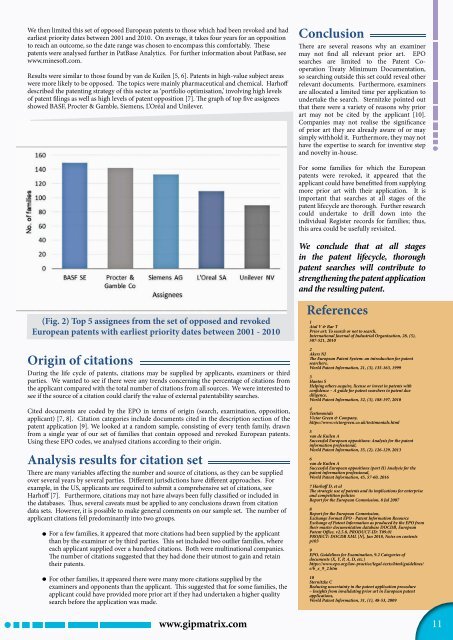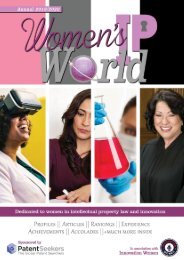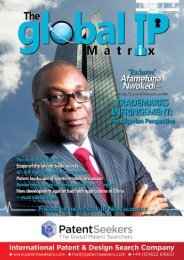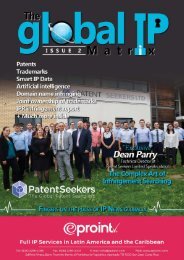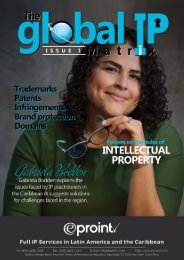Global IP Matrix - Issue 5
It has been a fantastic year for The Global IP Matrix magazine, thanks to all the efforts made by our contributors and to you, the reader for your continued support. We take great pleasure in putting together each issue of this publication, and we sincerely hope you enjoy this final issue of 2019. We have again, collaborated with some of the world's most influential IP law firms and businesses to bring you another eclectic mix of content, direct from the professionals working at ground level. We are already excited for the coming year and cannot wait to continue growing and evolving in our partnerships to bring you some exciting new features for 2020. Ms. Elvin Hassan Editor & Head of international liaisons
It has been a fantastic year for The Global IP Matrix magazine, thanks to all the efforts made by our contributors and to you, the reader for your continued support. We take great pleasure in putting together each issue of this publication, and we sincerely hope you enjoy this final issue of 2019. We have again, collaborated with some of the world's most influential IP law firms and businesses to bring you another eclectic mix of content, direct from the professionals working at ground level. We are already excited for the coming year and cannot wait to continue growing and evolving in our partnerships to bring you some exciting new features for 2020.
Ms. Elvin Hassan
Editor & Head of international liaisons
Create successful ePaper yourself
Turn your PDF publications into a flip-book with our unique Google optimized e-Paper software.
We then limited this set of opposed European patents to those which had been revoked and had<br />
earliest priority dates between 2001 and 2010. On average, it takes four years for an opposition<br />
to reach an outcome, so the date range was chosen to encompass this comfortably. These<br />
patents were analysed further in PatBase Analytics. For further information about PatBase, see<br />
www.minesoft.com.<br />
Results were similar to those found by van de Kuilen [5, 6]. Patents in high-value subject areas<br />
were more likely to be opposed. The topics were mainly pharmaceutical and chemical. Harhoff<br />
described the patenting strategy of this sector as ‘portfolio optimisation,’ involving high levels<br />
of patent filings as well as high levels of patent opposition [7]. The graph of top five assignees<br />
showed BASF, Procter & Gamble, Siemens, L’Oréal and Unilever.<br />
Conclusion<br />
There are several reasons why an examiner<br />
may not find all relevant prior art. EPO<br />
searches are limited to the Patent Cooperation<br />
Treaty Minimum Documentation,<br />
so searching outside this set could reveal other<br />
relevant documents. Furthermore, examiners<br />
are allocated a limited time per application to<br />
undertake the search. Sternitzke pointed out<br />
that there were a variety of reasons why prior<br />
art may not be cited by the applicant [10].<br />
Companies may not realise the significance<br />
of prior art they are already aware of or may<br />
simply withhold it. Furthermore, they may not<br />
have the expertise to search for inventive step<br />
and novelty in-house.<br />
For some families for which the European<br />
patents were revoked, it appeared that the<br />
applicant could have benefitted from supplying<br />
more prior art with their application. It is<br />
important that searches at all stages of the<br />
patent lifecycle are thorough. Further research<br />
could undertake to drill down into the<br />
individual Register records for families; thus,<br />
this area could be usefully revisited.<br />
Fig. 2 Top 20 jurisdictions by families, applications and grants<br />
(Fig. 2) Top 5 assignees from the set of opposed and revoked<br />
European patents with earliest priority dates between 2001 - 2010<br />
Origin of citations<br />
During the life cycle of patents, citations may be supplied by applicants, examiners or third<br />
parties. We wanted to see if there were any trends concerning the percentage of citations from<br />
the applicant compared with the total number of citations from all sources. We were interested to<br />
see if the source of a citation could clarify the value of external patentability searches.<br />
Cited documents are coded by the EPO in terms of origin (search, examination, opposition,<br />
applicant) [7, 8]. Citation categories include documents cited in the description section of the<br />
patent application [9]. We looked at a random sample, consisting of every tenth family, drawn<br />
from a single year of our set of families that contain opposed and revoked European patents.<br />
Using these EPO codes, we analysed citations according to their origin.<br />
Analysis results for citation set<br />
There are many variables affecting the number and source of citations, as they can be supplied<br />
over several years by several parties. Different jurisdictions have different approaches. For<br />
example, in the US, applicants are required to submit a comprehensive set of citations, see<br />
Harhoff [7]. Furthermore, citations may not have always been fully classified or included in<br />
the databases. Thus, several caveats must be applied to any conclusions drawn from citation<br />
data sets. However, it is possible to make general comments on our sample set. The number of<br />
applicant citations fell predominantly into two groups.<br />
For a few families, it appeared that more citations had been supplied by the applicant<br />
than by the examiner or by third parties. This set included two outlier families, where<br />
each applicant supplied over a hundred citations. Both were multinational companies.<br />
The number of citations suggested that they had done their utmost to gain and retain<br />
their patents.<br />
For other families, it appeared there were many more citations supplied by the<br />
examiners and opponents than the applicant. This suggested that for some families, the<br />
applicant could have provided more prior art if they had undertaken a higher quality<br />
search before the application was made.<br />
We conclude that at all stages<br />
in the patent lifecycle, thorough<br />
patent searches will contribute to<br />
strengthening the patent application<br />
and the resulting patent.<br />
References<br />
1<br />
Atal V & Bar T<br />
Prior art: To search or not to search,<br />
International Journal of Industrial Organization, 28, (5),<br />
507-521, 2010<br />
2<br />
Akers NJ<br />
The European Patent System: an introduction for patent<br />
searchers,<br />
World Patent Information, 21, (3), 135-163, 1999<br />
3<br />
Hantos S<br />
Helping others acquire, license or invest in patents with<br />
confidence – A guide for patent searchers to patent due<br />
diligence,<br />
World Patent Information, 32, (3), 188-197, 2010<br />
4<br />
Testimonials<br />
Victor Green & Company,<br />
https://www.victorgreen.co.uk/testimonials.html<br />
5<br />
van de Kuilen A<br />
Successful European oppositions: Analysis for the patent<br />
information professional,<br />
World Patent Information, 35, (2), 126-129, 2013<br />
6<br />
van de Kuilen A<br />
Successful European oppositions (part II) Analysis for the<br />
patent information professional,<br />
World Patent Information, 45, 57-60, 2016<br />
7 Harhoff D, et al<br />
The strategic use of patents and its implications for enterprise<br />
and competition policies<br />
Report for the European Commission, 8 Jul 2007<br />
8<br />
Report for the European Commission,<br />
Exchange Format EPO - Patent Information Resource<br />
Exchange of Patent Information as produced by the EPO from<br />
their master documentation database DOCDB, European<br />
Patent Office, v2.5.8, PRODUCT-ID: T09.01<br />
PROJECT: DOCDB XML [N], Jan 2018, Notes on contents<br />
p103<br />
9<br />
EPO, Guidelines for Examination, 9.2 Categories of<br />
documents (X, Y, P, A, D, etc.)<br />
https://www.epo.org/law-practice/legal-texts/html/guidelines/<br />
e/b_x_9_2.htm<br />
10<br />
Sternitzke C<br />
Reducing uncertainty in the patent application procedure<br />
– Insights from invalidating prior art in European patent<br />
applications,<br />
World Patent Information, 31, (1), 48-53, 2009<br />
www.gipmatrix.com<br />
11


